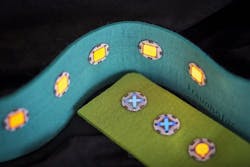Organic light-emitting diodes (OLEDs) are known mainly from their use in televisions and smartphone displays. They can also be used in lamps and car taillights. Now, the Fraunhofer Institute for Organic Electronics, Electron Beam and Plasma Technology (Fraunhofer FEP; Dresden, Germany), which partners for customer-specific OLED development and production, is now creating OLED elements that can be integrated into textiles. Fraunhofer FEP will be presenting on their results at the Electronics System Integration Technology Conference ESTC 2018 from September 18 - 21, 2018 in Dresden at booth no. 29.
OLEDs not only create saturated colors, but they can also be designed in any shape and even transparent or dimmable. Applied on wafer-thin foils, they are now finding their way into textiles. The range of applications is diverse and not limited to fashion trends or distinctive brand and design elements.
Jan Hesse, OLED design and integration specialist in the field of flexible organic electronics at Fraunhofer FEP, says, "The integration of luminous elements in clothing not only freshens up fashion designs, it can also create very concrete benefits: Luminous logos or applications are more easily noticed and considerably increase the visibility and thus the safety of the wearer, for example in road traffic.”
One example is workwear for night logistics. Since scientists can create OLEDs that emit in specific wavelength ranges, special applications such as in medicine are also conceivable. Light, including infrared light, for example, is successful in therapy of skin diseases; shirts could be made with integrated flat infrared lights for light therapy.
To simplify the integration of OLED elements in clothing and to give designers the opportunity to use the technology in an uncomplicated way, scientists at the Fraunhofer FEP have developed a functional button. This "O-Button" combines a wafer-thin foil-based OLED with a microcontroller on a conventional circuit board. This circuit board in the shape of a button is attached to the textile with conductive yarn and supplied and controlled with electrical power. The OLED itself is continuously dimmable. Two-color-variable variants of the button are also available. There are almost no limits to the structuring of OLEDs. The textiles finished in this way are intended to give designers ideas for new innovative designs and thereby open up further areas of application.
O-Button OLED samples can be obtained
Fraunhofer FEP provides samples of the O-Button for this purpose, can convert individualized designs into initial prototypes, and can be a partner up to pilot production. Scientists are already collaborating with designers in the fashion industry. Challenges regarding further textile integration, washability, and recycling are being tackled and further developed together with partners. The first OLED fashion will be on display in stores in about three years.
Source: https://www.fep.fraunhofer.de/en/press_media/14_2018.html?utm_campaign=pm1814en
About the Author
John Wallace
Senior Technical Editor (1998-2022)
John Wallace was with Laser Focus World for nearly 25 years, retiring in late June 2022. He obtained a bachelor's degree in mechanical engineering and physics at Rutgers University and a master's in optical engineering at the University of Rochester. Before becoming an editor, John worked as an engineer at RCA, Exxon, Eastman Kodak, and GCA Corporation.

